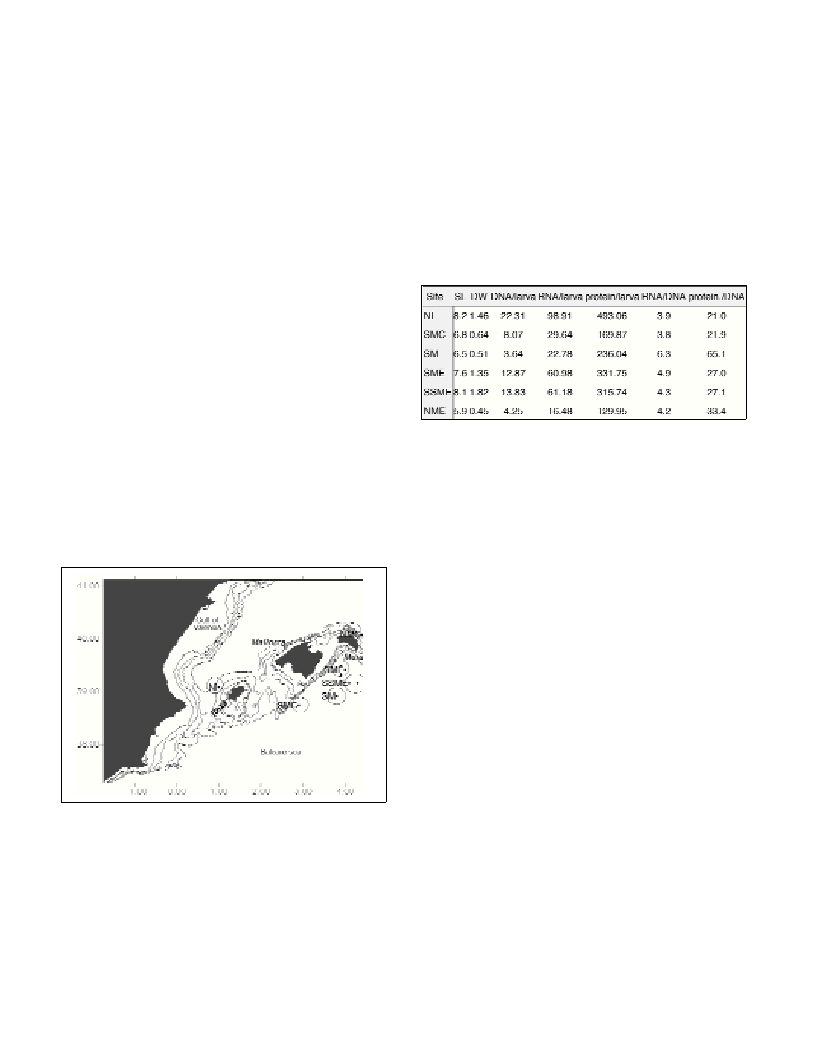FIRST DATA ON THE NUTRITIONAL CONDITION OF THE MEDITERRANEAN BULLET TUNA LARVAE,
AUXIS ROCHEI,FROM THE BALEARIC ARCHIPELAGO
D. Cortés *, A. García and T. Ramírez
Instituto Español de Oceanografía, Centro Oceanográfico de Málaga, Fuengirola, Málaga, Spain - * lcortes@ma.ieo.es
Abstract
Nutritional condition of bullet tuna post-?exion larvae was analysed by the quantification of nucleic acids and protein content from samples
collected off the Balearic archipelago. Highest RNA/DNA and protein/DNA ratios were observed in a cold water mass south of Mallorca.
Rapp. Comm. int. Mer Médit., 37,2004
337
Introduction
The waters off the Balearic archipelago constitute an optimum
spawning habitat for several tuna species, among which the bullet tuna
Auxis rochei is the most abundant, as shown by the results of the
TUNIBAL surveys (1), conducted during the spawning season of this
species, from June to September (2).
During the last decade some research has been done on
morphological, physiological and nutritional aspects of this species
with laboratory-reared specimens. Nutritional condition of wild-
caught bullet tuna larvae from the Panama Bight estimated by
histological techniques was examined by Margulies (3).
The present paper provides data on the nutritional status of
individual bullet tuna post-?exion larvae from the Balearic spawning
grounds.
Material and methods
The methodological protocols used to determine the content of
RNA, DNA and protein is described in (4). Larvae were collected by
means of 1-m Bongo net (1mm mesh size) towed at the surface during
the TUNIBAL 06/01 survey.
Results and discussion
A total of 118 bullet tuna post-?exion larvae were analysed for
RNA, DNA and protein content. The samples were obtained at
different sites off the Balearic islands each characterized by particular
hydrographic conditions (Fig. 1). The average size of the sampled
population was 7.3mm standard length (SL) (sd=1.24) and 1.12 mg
dry weight (DW) (sd=0.86). The biochemical parameters showed a
significant exponential increase with length and weight (p<0.05).
Fig. 1. Sampled sites of the bullet tuna larvae.
The survey area is characterized by the encounter of two water
masses: Mediterranean waters from the north meeting waters of
Atlantic origin, which cause important frontal systems and an intense
ageostrophic circulation. (5). The sampled population belong to sites
with different hydrographic characteristics (1). The north Ibiza (NI)
and Mallorca channel (SMC) sites were located within intense frontal
structures. Mean surface temperature (at 5 m) in these sites was 24ºC.
Another larval sample was collected south of Mallorca (SM) within a
colder water mass (22ºC). South off Menorca (SME), larvae were
sampled within an anticyclonic gyre. South of this anticyclonic gyre,
at SSME, another larval sample was collected. In the latter two areas,
the mean surface temperature was 24-25ºC. Another larval sample
was collected at a site north of Menorca (NME) with a surface
temperature of 24ºC. The average size of the sampled population and
biochemical parameters by site are given in Table 1.
Table 1. Average values of the sampled population and the biochemical
parameters by site (NI, North Ibiza; SMC, South Mallorca Channel; SM,
South Mallorca; SME; South Menorca; SSME, Southermost Menorca;
NME, North Menorca; SL, standard length; DW, dry weight.
The RNA/DNA and protein/DNA ratios were significantly higher
(ANOVA-Tukey post hoc comparison; p<0.05) in the samples
originating from the cold water site (SM). The remaining areas, that
had similar temperature regimes, did not show any significant
differences in biochemical ratios, with the exception of the slightly
higher values in the site SME. The higher values observed at SM do
not necessarily imply a better nutritional status for bullet tuna larvae.
The RNA/DNA dependence on temperature might cause variability in
the ratios (6). Larvae located at SME showed better condition with
respect to larvae sampled at other sites with similar temperature
regimes. In general, the nutritional condition of the sampled
population can be considered adequate, in agreement with (3) who did
not find signs of malnourishment of bullet tuna post-?exion larvae
from the Panama Bight.
References
1-García A., Alemany F., Vélez-Belchí P., López Jurado J.L., de la Serna
J.M., González Pola C., Rodríguez J.M. and Jansá J., 2002. Bluefin tuna
and associated species spawning grounds in the oceanographic scenario of
the Balearic archipelago during June 2001. ICCAT, SCRS/02/41.
2-Sabates A., and Recasens L., 2001. Seasonal distribution and spawning
of small tunas (Auxis rocheiand Sarda sarda) in the northwestern
Mediterranean. Sci. Mar. 65(2): 95-100.
3-Margulies D., 1993. Assessment of the nutritional condition of larva
and early juvenile tuna and Spanish mackerel (Pisces: Scombridae) in the
Panama Bight. MarineBiology, 115: 317-330.
4-Moksness E., Belchier M., Clemmesen C., Cortés D., Doan A.,
Folkvord A., García A., Geffen A.J., Høie H., Johannessen A., Pontual H.,
Ramírez T., Schnack D., and Sveinsbø B., 2000. Manual of Tools for
Recruitment Studies (PARS).Final Report UE FAIR CT 96-137.1997-
1999.
5-Vélez-Belchí P., and Tintoré J., 2001. Vertical velocities at an ocean
front. Sci. Mar., 65: 301-304.
6-Goolish E.M., Barron, M,G., and Adelman, I.R., 1984.
Thermoacclimatory and response of nucleic acid and protein content of
carp muscle tissue: in?uence of growth rate and relationship to glycine
uptake by scales. Can. J. Zool., 62: 2164-2170.

